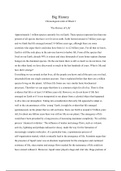Big History
Chronological order of Block I
‘The History of Life’
Approximately 1 trillion species currently live on Earth. These species represent less than one
percent of all species that have ever lived on earth. Earth formed around 4.5 billion years ago
and we think that life emerged around 3.4 billion years ago, although there are some
scientists who argue that it could also have been 4.1 to 4.2 billion years. For all that we know,
Earth is still the only place in the universe known to harbor life. From all the species that
lived on our Earth, already 99% is extinct and since thousands of years homo sapiens (human
beings) are the dominant species. On the one hand, there is still so much we do not know, but
on the other hand, we have discovered so much in the last hundreds of years. What is life and
how did it emerge?
Everything we see around us that lives, all the people you know and all the pets you ever had,
descended from one single common ancestor. I have explained before that there are a trillion
species living on this planet. All these life forms use very similar basic biochemical
processes. Therefore we can argue that there is a common origin for all of us. There is firm
evidence that life is at least 3.4 billion years old. However, we do not know if life first
emerged on Earth or if it was transported to our planet from a celestial object that happened
to dive into our atmosphere. Taking into consideration that early life appeared to adapt so
well to the circumstances of the ‘young’ Earth, it might be evident that life emerged
spontaneously on the planet that we call our home. Since our Earth is around 4.5 billion years
old, for about one billion years there was still no life on our planet. The emergence of life
would have been preceded by a long process of increasing inanimate complexity. We call this
process ‘chemical evolution.’ The influence of matter and energy flows, such as volcanic
activity, lightning and perhaps radioactive decay, made the way for the formation of
increasingly complex molecules. At a particular time, a spontaneous process of
self-organization started, which eventually lead to the emergence of life. Scientists argue that
the presence of liquid water was an absolute requirement for the emergence and continued
existence of life, since matter and energy flows needed for the sustenance of life could not
have existed without it. Moreover, liquid water played a huge and vital role. Huge portions of
, water such as oceans, had a dampening effect on temperature fluctuations caused by
fluctuating energy flows from the outside. This is possible, because water can absorb a great
heat without letting the temperature rise drastically. Therefore, a situation where water is able
to stabilize temperatures and pressures occurs, which would have helped early life to survive.
Furthermore, salt concentrations that we see today in our oceans are very similar to the
average salt concentration in living cells. If the salt concentration of the first cells had varied
a lot from the surrounding water during their emergence, the early cells would have been
destroyed.
To go a little bit deeper, the process that lead to the emergence of life was not a process
merely based on chance encounters of atoms and molecules. It were multiple connected
processes that were constrained with each other. Although, some of these processes are still
unknown to us, life is very special compared to other phenomena that we see in the universe.
For instance, compared to galaxies, stars and planets, even the largest forms of life are tiny.
However, life generates much more power densities compared to objects that contain no life.
To explain it in a different way, we can state that life is, in contrast to stars, able to generate
considerably higher power densities while at the same time maintaining the right Goldilocks
circumstances.
With the emergence of life a new mechanism that could achieve even greater complexity
emerged as well. Whereas stars and galaxies thrive on the use of energy that comes from
supplies of matter and energy that comes from themselves (stored inside the star/galaxy),
everything that lives continuously uses matter and energy flows from their surroundings to
‘keep living’ and perhaps reproduce. All biochemical compounds that are produced by cells
have ‘tasks’ to fulfill so the organism can survive. An organization like this has not ever been
seen in a lifeless matter. Moreover, because life uses the energy from its surroundings, it can
exist in, and also maintain, moderate temperatures that actually favor the emergence and
continued existence of more complex molecules. This is possible because biomolecules are
able to store information. All life forms contain metabolistic processes, which controls their
own reproduction as well as the energy-generating and energy-consuming processes. These
processes take place inside cells, which are the ‘building blocks’ of life, since all organisms
consist of cells. We as human beings, are complex organisms and we consist of many cells
that ‘cluster’ together, whereas there are very simple life forms that come in the form of
single cells. In these cells molecules are produced and maintained which are needed for the





